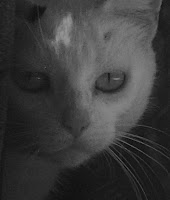


Concerning The New Criticism or Yeats’s “The Cat and the Moon,” I am a nearly empty suit (or empty corduroy jacket?). Of course, that didn’t stop me from going on and on about The New Criticism back on August 10,18,19,20 of this year.
Now Altadena Hiker has issued a desperate plea for more blather (is that like more cow bell?). Eager to please, but also to protect myself from charges of impersonating competent scholarship or gross pedantry, I offer here some quasi-New Critical, quasi-academic remarks about Yeats’s “The Cat and the Moon,” first posted on October 31. In fact, I offer so many remarks (surely you're not surprised) that I’ll divide them into two posts, today and tomorrow or Thursday.
First, here is the poem again:
THE CAT AND THE MOON
by: W. B. Yeats (1865-1939)
The cat went here and there
And the moon spun round like a top,
And the nearest kin of the moon,
The creeping cat, looked up.
Black Minnaloushe stared at the moon,
For, wander and wail as he would,
The pure cold light in the sky
Troubled his animal blood.
Minnaloushe runs in the grass
Lifting his delicate feet.
Do you dance, Minnaloushe, do you dance?
When two close kindred meet,
What better than call a dance?
Maybe the moon may learn,
Tired of that courtly fashion,
A new dance turn.
Minnaloushe creeps through the grass
From moonlit place to place,
The sacred moon overhead
Has taken a new phase.
Does Minnaloushe know that his pupils
Will pass from change to change,
And that from round to crescent,
From crescent to round they range?
Minnaloushe creeps through the grass
Alone, important and wise,
And lifts to the changing moon
His changing eyes.
* * *
Opponents of the New Criticism—let’s say New Historicists or Deconstructionists—would probably dwell on the fact that Minnaloushe belonged to Maude Gonne, Yeats’s major love interest. Those biographical facts might seem essential to many serious, well-intentioned readers. Those readers would also pay much attention to Yeats's theories of history, the “phases” of the moon, and the way Yeats found important patterns occurring in the shape of a spiral or “gyre” (hard g). So line 2, "the moon spun round like a top," might well suggest a gyre and the onset of an epoch of some kind.
If the moon spins like a top, it could tip; it’s a moon that’s occasion for crazy-cat waltzing and mysterious feline wisdom. But do we need all that to understand, appreciate, and enjoy the poem, especially when much of its tone and mood feel like a children’s song?
Yeats was also caught up in Byzantine art and Gaelic mythologies, plus early 20th century Irish politics. While the portions of New Critic in my corduroy don’t mind if we talk about such background material as interesting supplements, the minute someone says we cannot understand a poem without that information or speculation, or the poem is only there to serve or illustrate its historical or cultural context and be of little value in its own right, as an aesthetic object that’s relevant in any historical period, at least in the West—then my corduroy gets its dander up.
Because writers lie and die and deceive themselves, they are unreliable interpreters of their own work. So The New Criticism has the integrity to pay attention primarily to the poem itself, the words on the page, the imagery and figurative language, the punctuation, the line breaks, the music produced by meter and other sound devices like alliteration and assonance.
A writer fathers or mothers a poem into the world; we are the world, conversing at length with the child-poem, which is now an adult. We don’t begin by asking who his daddy was or what his daddy thought of him or in what country and epoch his daddy was a citizen. The child has been put into the streets and now must stand on his own, stared at and questioned by strangers.
So tomorrow or Thursday I’ll attempt at a bit of that questioning in an approach I think of as New Critical. I hope to show that we can get the core meaning and beauty of this poem and most others without digging into history books or literary scholarship.



















2 comments:
(My computer shut down in the middle of my comments, so if they made it thru, please delete this one.)
I was ready to start screaming and throwing things after reading your first graph. I brought out my trusty notepad and had written, "no!no!no!" (That's about as good as my notes ever get.)
But what do you know, I agree 100% with everything you said after that. And you said it so beautifully. Criticism is rarely poetic.
I would just take things one step further and say, pretend each work is an orphan. Once you let the parents in, you'll never get them out again.
I love the orphan image!
I've gotta give that first paragraph another look! Of course, causing someone to get out her notepad is not all bad either. It's been a long time since I've tried this kind of writing, so I hope you're at least a bit right in thinking I've said a few things respectably.
While I agree with you about most literary criticism, I've recently enjoyed W.S. DiPiero, Dan Chiasson and others in the commentary sections of Poetry Magazine. Also, reaching back some years or decades, my impression is that I liked Robert Langbaum, Helen Vendler, and Harold Bloom, among others.
Post a Comment